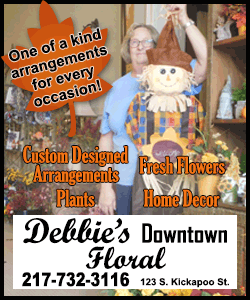|
 These
demonstrations included blacksmithing, apple butter making, wool
spinning, and wood carving. Each of the demonstrations was being
conducted in a way that was true to how each of these would have
been done in Abraham Lincolnís time. These
demonstrations included blacksmithing, apple butter making, wool
spinning, and wood carving. Each of the demonstrations was being
conducted in a way that was true to how each of these would have
been done in Abraham Lincolnís time.
A very informed young lady named Trinity Bussan was simultaneously
educating people on the process of making apple butter while mixing
a pot of it. Bussan shared that, while today all you would need is a
crock pot and about three hours, the process of making apple butter
in the 1800s was much more labor intensive. The recipe includes
applesauce, apple cider, sugar, and cinnamon. The ingredients are
put into a large copper pot and placed over an open fire. Bussan
further shared that the apple butter must be continuously stirred
with a large wooden paddle. When she shared that information, it was
just after 2 p.m., but the apple butter had been put on earlier that
morning. Once the apple butter begins to stick to the paddle, thatís
when you know itís finished. Bussanís grandfather shared that
cleaning the pot is just about as labor intensive as the cooking
process, requiring salt, vinegar, and lots of elbow grease. He
additionally shared that overcooking the apple butter could cause it
to take on a rubber-like consistency.

Just next to the encampment where the apple butter
was cooking, Nick Reinhart was showing passersby the process of
blacksmithing. At the time, he was working on a tomahawk, and
educated those watching about this process. Blacksmithing, Reinhart
explained, is just about moving the metal where you want it. Having
begun with a small square of metal, Reinhart heated the metal up to
make it malleable before working it into a tomahawk shape. With only
one blacksmith, this process could take an entire day. He used a
special tool to make the hole in the base of the tomahawk head where
the wooden handle would be placed. The hole has to be teardrop
shaped to keep the tomahawk from veering off one way or another when
used. A circular hole, as may be found at the base of the head of a
hammer, just wouldnít work with this tool.
[to top of second column] |

Robert and Emily Grady were showing off the processes
of wool spinning and wood carving, respectively. Emily was feeding
roving into the spinning wheel she was using to spin her wool.
Roving is a term used to describe wool before it is spun into
string. The speed Emily fed the roving into the spinning wheel
determined how thick the string would be. Next to her station, Emily
had a metal ring full of different colored sections of string. Emily
shared that she had made these herself, using natural dyes to get
each of them to be the color they were. Speaking more on natural
dyes, Emily shared she sometimes picks flowers from the roadside to
turn into dyes for her wool. Certain colors, like blue, are harder
to come by, and she has to order them. For this color, Emily shared
that she special ordered it from Oaxaca, Mexico. There, people farm
the cochineal bug to turn into a deep bluish indigo dye.
Robert shared the same station as Emily but had a completely
different skill set to show off. Robert is a wood carver and was
using his carving tools to make wooden spoons. There was a large
pile of wooden spoons next to Robertís station, all having been hand
made by him. Robert shared that he has probably made thousands of
wooden spoons in his time. He also shared a bit about his past in
wood carving, and how he came to enjoy this hobby so much. Robert
got started wood carving around 1969-1970. Some of the tools he was
using could even be traced back to the mid 1800s. Robert also shared
a story of when he went to a historical recreation. The recreation
had things from before the 1700s, and someone was making stew in a
traditional fashion. When Robert asked them where the ladle for the
stew was, they pointed to a metal ladle with a K-Mart label on it.
Robert jokingly asked them to turn off the blue light, referring to
K-Martís blue light special sales. He decided to make them a
handmade wooden ladle and delivered this to them the next day.
[Matt Boutcher]
 |